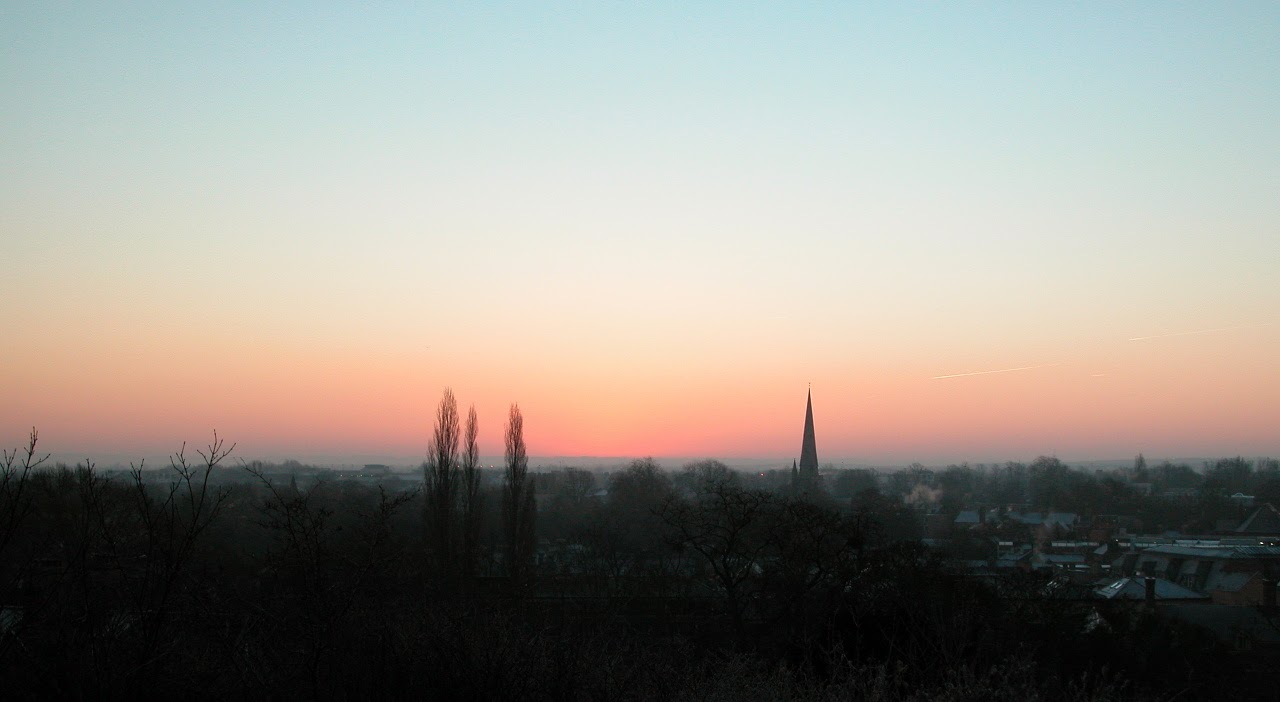"You're right," my rational mind responded. "How embarrassing! After all this build up, and telling all my friends and family about taking flying lessons, I am going to have to tell everyone you couldn't handle it." I felt awful for a few seconds. In a way, the fear of looking like a right charlie felt worse than the flying itself. But I soon got over it. The ground receded below us until it looked more like an unfolded map than a dangerous fall, and monkey brain stopped worrying about it.
 | |
| Cambridge skyline. If the trees weren't there you could put a ruler to that. |
It didn't take long before we arrived at the training area, and as the instructor started telling me what to do, I quickly realised why the briefing had been so detailed. In the open cockpit, between the air rushing past at 70 mph and the Gipsy Major engine making 2000 revolutions, it was already noisy. But the wind was also hitting the mics and adding extra noise to the intercom system. It was only by recognising that the instructor was repeating much of what he'd said on the ground that I could understand him at all. Even then, I don't think I've ever said "Say again" so many times.
The instructor started by telling me to "follow through" by holding the stick loosely to feel what he was doing while he demonstrated moving the stick forwards to descend a little, and back to climb a little, and to let me feel what that was like. I found it quite a disconcerting a feeling at first, and I nearly stuck my hands in the air as one does on a roller coaster. I'd warned myself during the briefing that I would probably be too cautious with the controls. I'm naturally a bit of a scaredy-cat - I didn't even like to climb trees as a boy - so it was all too plausible I would grip the stick tight as if even a millimetre's movement would send us tumbling to the ground. The roller coaster feeling convinced me it would be a battle with fear. Over the noise, I heard, "You have control," and I started the manoeuvre.
In fact, having followed through his demonstration, I knew where the stick needed to go, and wasn't afraid of putting it there. I found that the feeling of motion was a lot more comfortable when I was the one controlling it: less like being on a roller coaster, and more like flying, of one's own volition. After all, if you jump up and down, or go rock climbing, or ride a bike, the motion doesn't feel uncomfortable, it just feels natural. I briefly wondered if it must be really hard as an instructor, to feel that rising and sinking under someone else's control so much of the time. But I didn't let my mind wander too far, and if my first climb and descent were a little uncertain, the second felt spot on. The instructor was pleased in the debriefing that I was "confident handling the plane".
 |
| The fore-and-aft seating in the Tiger Moth. Photo courtesy of Christopher Bazley. |
After climbing and descending with the elevators, I got to try out the other controls: ailerons, rudder, throttle, and elevator trim. All too soon it was time for us to land. By now the sun was near the horizon, and almost exactly in line with the runway, so we were forced into landing with the sun in our eyes. Right after the instructor flared, thinking we were 10-20 feet above the runway, we were both surprised by bouncing off the grass. He quickly recovered and the second touch-down was perfect.
Just as a budding jockey gets to rub down his horse with a wire brush, so does the last pilot of the day have to tend to his steed. The Tiger Moth tends to spread its oil around the inside of the engine cowling, and the bottom of the fuselage. I had to wipe it off with a rag while it was still runny, before the engine cooled down. I had my arm and hand in a few odd positions to make sure to get all the surfaces without burning myself on any hot engine parts. Mud from the grass runway also needs to be wiped off the lower wing and tailplane to keep them in good condition. Everyone helped out, so it wasn't long before the spotless airplane was ready to be pushed into the hangar.
Now that winter is upon us, it might be a while before I get another chance to fly these yellow beauties, but I feel like I'm halfway to becoming a pilot already. There's plenty of ground-work to do in between sorties, so even when my feet are on the ground and there is only grey above me, my head will still be there, between cockpit and sky.
No comments:
Post a Comment